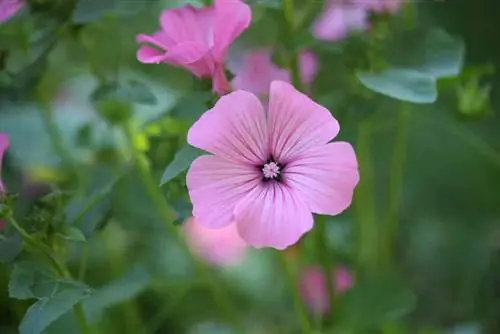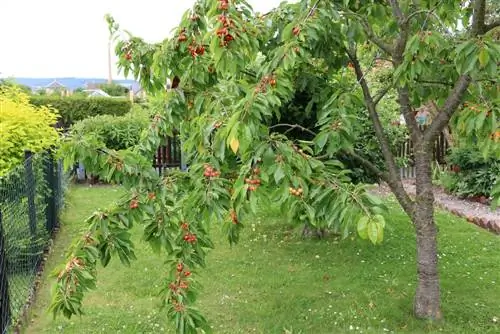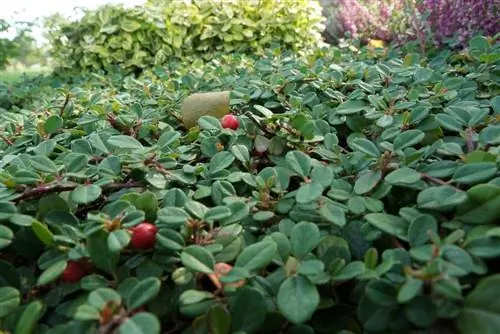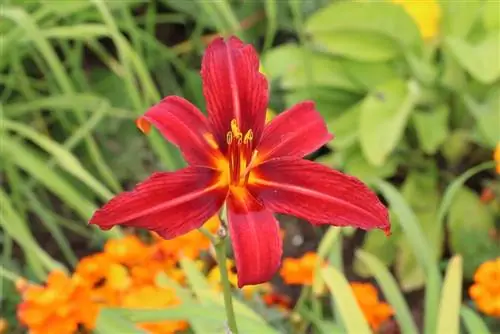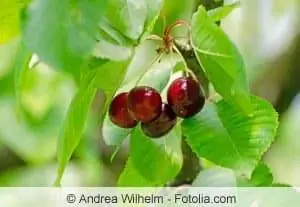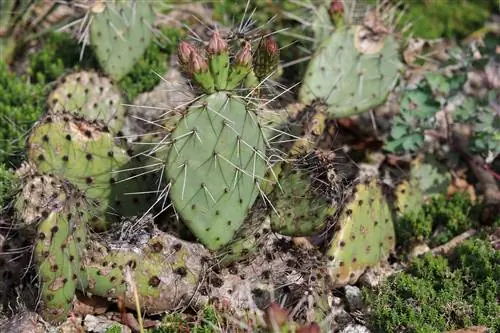- Author admin [email protected].
- Public 2023-12-17 03:39.
- Last modified 2025-01-24 12:45.
The mallow is a beautiful and undemanding garden plant that is particularly suitable for being planted in groups. It is equally suitable for the farmer's garden as well as for the perennial or rock garden.
Location and soil requirements
In general, mallows are very undemanding plants. They like to grow in nutrient-rich and dry to slightly moist soil. It is important that the soil is slightly calcareous, humus-rich and generally permeable. However, mallow does not tolerate peat very well and will therefore either not thrive at all or only thrive very poorly in soil containing peat. The uncomplicated plant also accepts clayey and moderately moist as well as slightly dry and sandy soils without any problems. In dry phases, the plant should always be watered well, but without causing waterlogging. When it comes to location, mallows have a clear preference: it should be sunny. But they can also cope with partial shade.
Mallows should always be planted in groups of three to five plants. It is important that the plants have sufficient distance from their neighbors for their development. You should keep in mind that mallows grow very tall and should therefore be given a place protected from the wind. In addition, the plants should be secured to a trellis or a stick so that they do not ultimately break off despite being in a protected location.
The preferences of mallow at a glance:
- nutrient-rich, slightly dry to moist soil
- slightly calcareous, humus-rich and permeable soil
- protected from peat particles in the subsoil
Garden or pot care
If there's one thing that the undemanding plant doesn't like at all, it's waterlogging, which occurs when watering or due to a lot of rain. Therefore, when watering the plant, you have to make sure that it doesn't get too much or too little water and that excess water can drain away easily. This is particularly important if the plant is kept in a pot - which, by the way, is a completely unproblematic solution for the mallow. However, the mallow depends on regular fertilization. The plant grows very tall, which means that it can reach a height of 1.50 m to 2.00 m. That's why it makes sense to let them grow up a trellis as a privacy screen and thus provide natural protection from the plant's gaze.
The most important care instructions:
- moderate but regular watering
- absolutely no waterlogging
- regular fertilization
pruning
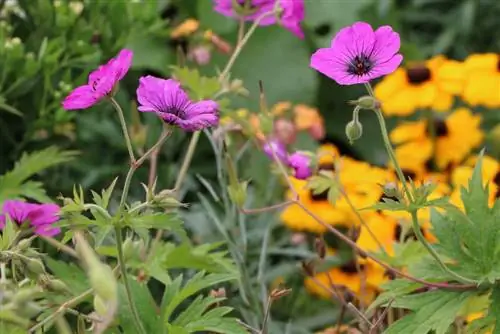
While trimming is not necessary for annual mallows, perennial species should be trimmed. This way you can avoid bare stems and the plant will have dense and lush growth. The type of cut depends somewhat on the type of mallow. In general, woody mallows can be cut back completely, while species with softer stems should be treated carefully with the trimmings. The cutting should take place in spring and autumn. If the winters in your region tend to be very cold, then it makes more sense for the plant if it is cut in spring. If you cut back woody mallow heavily in the fall, you should at least ensure that the remaining plant is well protected from the cold over the winter.
Propagation
Mallows are propagated by sowing seeds and are completely problem-free and uncomplicated. For the next sowing, you can collect the seeds in late summer when the lower flowers bloom. However, it is also possible to cut off the spent inflorescences and preserve the perennial for several years. The seeds can be sown immediately after the harvest - either directly into the ground or in pots. It is very useful to grow the seeds indoors for quick flowering. Once the plants have reached a stable size, they can be pricked out. The pots with the small mallows can be covered over the winter in the basement and then planted out in the garden the following spring. If you sow the seeds directly into the bed in spring, you must expect that the plant will not bloom until the following year.
Pests and diseases
A big problem with mallows is often mallow rust infestation. This is a fungus that causes brown pustules on the undersides of plant leaves. Over time, these pustules then become holes in the leaves. Ultimately, the affected leaves die completely. In order to stop the plant from becoming ill, it is important to remove individual affected leaves immediately so that the disease cannot spread further. The diseased leaves should not be disposed of in the compost, but rather in the household waste. If multiple plants are affected, mallow rust control must be approached more comprehensively. In this case, using a tincture made from field horsetail is very useful. If the plants are very severely infested, treatment with a pesticide from a specialist retailer may be necessary.
It is therefore important to make sure that you choose a largely resistant variety when buying your first mallow. Once the disease has been introduced into the garden, the entire plant and the surrounding soil should be destroyed in the fall. This is the only way to avoid the next generation of mallows being affected by the disease next spring.
What you should know about mallow in brief
Mallows impress with their great flowers in many colors and shapes. They are hardly missing in any garden. There are different types including:
- Prairie mallows
- bush mallows
- Mallows
- Hollyhocks
- Marshmallows
- Beautiful mallows
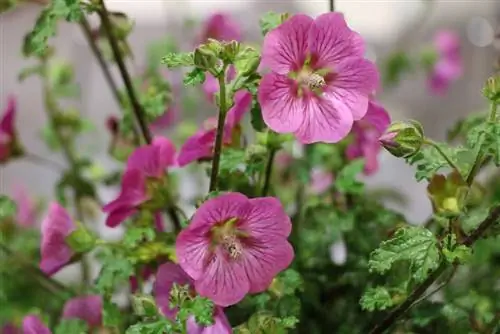
Some mallows are annual, others are biennials and perennials. There is something for every garden lover in this selection. The care is usually quite simple. Caution is advised when it comes to winter hardiness. Some species cannot tolerate deep frost and must be protected.
Location
- Mallows grow best in the sun. However, light shade is often sufficient.
- Species like the bush mallows reach enormous sizes. You need enough space.
- Other species such as hollyhocks like to stand on the fence where they can be looked after. Their long stems are susceptible to wind.
Planting substrate
Mallows grow in almost any soil, but it shouldn't be too wet
Watering and fertilizing
- During the flowering phase, the plants need sufficient water.
- When keeping in the bucket, make sure that excess water can drain away easily.
- Standing water is not tolerated.
- A lot of fertilizer is needed for the formation of the flowers and also for their maintenance.
Propagation
- Propagation is easy. You can sow seeds.
- The plants often sow themselves.
- The seeds can be planted in the ground immediately after harvesting.
- If they are sown in spring, the mallows will not bloom until next year.
cutting bush mallow
The bush mallow is best cut back in spring and quite radically. Leave a maximum of a third of the plant standing. If you don't cut, the plant will go bald and hardly have any flowers left. A cut is tolerated very well. The flowers only appear on this year's wood. The growth is enormous.
Cutting beautiful mallow
The beautiful mallow is not hardy. It needs to be kept warm over the winter, at 12 to 15 ˚C. If you move the beautiful mallow, you can cut it straight away. The plant is trimmed so that it does not go bald. This measure will be repeated in the spring. In particular, the long shoots that arise in winter due to too little light must be cut away.

